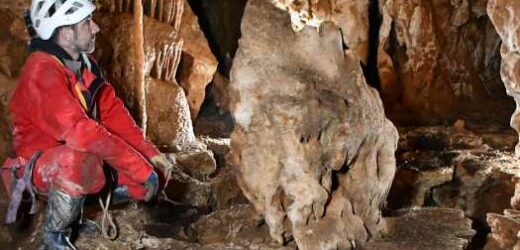Hunting scenes, geometric patterns, hand stencils and other works of prehistoric art can endure for tens of thousands of years on the walls of well-protected caves — but only if bats don’t hang out in the galleries.
These flying mammals are simply looking for a safe place to roost, but they also become furry philistines that erase ancient paintings and other cave wall markings within a few decades because of the corrosive property of their feces, or guano, according to research by a team of geologists and archaeologists published in May in the journal Geomorphology.
In Jamaica’s Green Grotto caves in the early 2000s, two scientists, Joyce Lundberg and Don McFarlane, showed that roosting colonies of bats create their own microclimates that can gradually erode a tropical cave’s limestone. Over the following decades, more research pinned down the destructive details. Studies have shown how large masses of bats generate heat and humidity within a cave’s closed confines, slicking the walls with an acidic, carbon dioxide-rich film. In addition, large quantities of bat guano and urine can ferment and saturate the air with aerosolized particles of phosphoric acid. This potent combination eats away at the limestone walls and ceiling, a process called biocorrosion.
A group of geomorphologists in France wanted to know whether the same process plays out in bat-filled caves across Europe, where prized cave paintings like those in France’s Chauvet and Lascaux caves offer ornate windows into our past.
They focused on one cave system in particular, known as the Azé caves, in eastern France. Bones found in the cave suggest it was a home to cave bears beginning about 150,000 years ago. Humans lived and worked in the cave throughout the Bronze Age some 3,000 years ago. And it has for centuries been visited by tourists drawn to its limestone labyrinths and underground river. At other tourist caves in the region, visitors over the years have scrawled graffiti, but the entry chamber to Azé is perplexingly pristine, said Lionel Barriquand, a geomorphologist at Savoy Mont Blanc University and the study’s lead author.
Azé has also been a major bat roosting site for the past 45,000 years. While encroaching human development has significantly reduced the cave’s population, many thousands of bats once packed the cave’s walls and ceiling, covering surfaces with layers of guano. Yet bats were blocked from the innermost parts of Azé by a thick plug of calcite around 22,000 years ago. This inner sanctum was unplugged in 1963, offering scientists a natural experiment to compare its walls with those of the cave entrance.
They found the walls of the long-blocked section of the cave were more jagged, with fewer and shallower recesses in the ceiling than the entrance. The inner cave also featured numerous bear claw marks along its walls, while none exist in the parts of the cave where bats have been living. By comparing measurements from the two sections, the scientists determined that the presence of bats had caused the walls of the cave entrance to retreat by about 3 to 7 millimeters every thousand years. The cave entrance lacks any cave art, graffiti or claw marks, they concluded, because bat-driven erosion made all such markings crumble to dust.
“The more bats you have, the more intense the process will be,” said Philippe Audra, a geomorphologist at Côte d’Azur University and a co-author of the study. A surface painting on the walls of Azé would disappear within about 25 years, the researchers said.
Biocorrosion is an important yet underappreciated aspect of understanding why prehistoric cave paintings are so often found in caves that have been sealed off from the outside world or never hosted bats, said Laurent Bruxelles, a geoarchaeologist at the French National Centre for Scientific Research who collaborates with Dr. Barriquand’s team but wasn’t involved in the recent study.
“Paintings are the first things to erode away due to biocorrosion,” he said. “In every cave where there are bats and paintings, the paintings disappear.”
Dr. McFarlane, who helped pioneer the bat biocorrosion work and is a paleobiologist at Claremont McKenna College in California, said the study was a useful application of his earlier research on archaeology. He added that anthropologists should consider these effects when looking at patterns of where cave art is and isn’t found.
“A lack of cave art might simply reflect bat occupancy,” he said, “rather than some fanciful anthropological explanation.”
Source: Read Full Article



